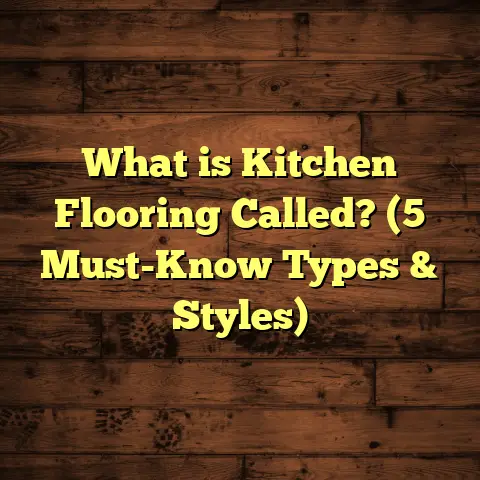What is Laminate Flooring? (5 Key Benefits You Didn’t Know)
When I first got into flooring, one thing that caught my attention immediately was how floors aren’t just one solid piece; they’re made up of layers. Each layer is carefully designed to serve a purpose—whether it’s providing strength, appearance, moisture resistance, or comfort underfoot. Laminate flooring perfectly illustrates this layering concept. It’s not just a single material slapped on the floor—it’s a product engineered with multiple layers working together to give you the look of wood or stone, with added benefits that make it practical for everyday life.
I bet you didn’t realize how much goes into laminate flooring’s design and why it’s become so popular in homes and commercial spaces alike. Let’s explore what laminate flooring really is, how it stacks up against other flooring options I’ve worked with, and five key benefits that might surprise you.
What exactly is laminate flooring?
Laminate flooring is a synthetic flooring product created by bonding several layers together through a lamination process. Its core is typically made from high-density fiberboard (HDF), which provides durability and stability. Above this core lies a photographic applique layer—a high-resolution image that replicates the look of natural materials like hardwood, stone, or tile. The topmost layer is a transparent wear layer that protects the floor from scratches, stains, and impacts.
Think about it like a sandwich: the bottom layer supports everything, the middle layer gives it the look you want, and the top layer acts like a shield to keep it looking great over time.
This construction method allows laminate flooring to mimic the appearance of expensive natural materials but without the same upkeep or cost. The photographic layer can be incredibly detailed, capturing wood grains, knots, and textures that even trained eyes can struggle to distinguish from real hardwood.
How laminate flooring layers work
- Backing layer: This stabilizes the plank and provides moisture resistance.
- Core layer (HDF): Made from compressed wood fibers bonded with resin, this gives the floor strength and dimensional stability.
- Decorative layer: A high-resolution printed image that determines the floor’s look.
- Wear layer: A tough melamine resin coating that protects against scratches, stains, and fading.
The wear layer is particularly important because it’s what handles everyday foot traffic, spills, and pet claws. The thickness and quality of this layer often determine how long your laminate floor lasts.
My journey with different flooring types
Over the years, I’ve installed various floors—solid hardwood, engineered wood, vinyl planks, ceramic tile, carpet—and each one has its place depending on budget, style preferences, and practical needs.
Hardwood floors have always been the classic choice for many homeowners. The natural beauty and warmth you get from real wood are unmatched. But those floors come with challenges—high upfront cost ($5-$15 per square foot just for materials), susceptibility to dents and scratches, and vulnerability to moisture damage. Plus, installation can take days or weeks if you factor in sanding and finishing.
Engineered hardwood is a clever alternative that offers better stability against temperature and humidity changes. You still get real wood on top but with plywood or HDF underneath to reduce warping. However, these floors remain pricey and require professional installation.
Vinyl planks have surged in popularity recently because they’re waterproof and affordable. But their look and feel often don’t match the realism of laminate or hardwood. They can sometimes feel “plastic” underfoot.
Carpet brings softness and warmth but traps dust mites and allergens, making cleaning tougher—something I witnessed firsthand when installing floors for allergy-prone clients.
Laminate flooring hits a sweet spot in many cases: it offers the look of wood or stone at a fraction of the price with easier installation and maintenance. In my own home, I replaced worn-out carpet with laminate in our basement playroom after dealing with constant stains and allergies from dust buildup. The kids love the wood look, and my wife appreciates not having to deep clean weekly.
Five benefits of laminate flooring you probably didn’t expect
1. Durability that stands up to real-life challenges
When clients first hear about laminate flooring, they often worry it will scratch or wear out quickly. But good quality laminate comes with abrasion class (AC) ratings ranging from AC1 (light residential use) to AC5 (heavy commercial use).
For homes, AC3 or AC4 is usually perfect. I’ve seen AC4 laminate installed in busy family rooms where kids run around with shoes on hardwood floors that show scratch marks within months—but not on this laminate.
A study by the World Floor Covering Association found that commercial-grade AC5 laminate could withstand heavy foot traffic for up to 10 years before needing replacement. That’s comparable to some hardwood finishes.
In one project I managed for a daycare center, we installed AC5 laminate due to its scratch resistance and ease of cleaning. After two years of daily activity with toys dragged across the floor and spilled paint, the laminate still looked great.
The protective wear layer’s melamine resin coating plays a major role here—it resists abrasions from dirt grit brought in by shoes and protects against minor spills.
2. Simple installation saves time and money
Laminate flooring often features click-lock or snap-together systems that allow floating installations—meaning planks lock together without nails or glue.
This design enables many homeowners to install their floors themselves over a weekend if they’re comfortable with basic DIY tasks. I’ve helped friends do exactly that in living rooms and kitchens without needing special tools beyond a saw and spacers.
Professional installers also appreciate how much faster laminate goes down compared to hardwood or tile—cutting labor costs by up to 50%. This means you can redecorate your home faster without sacrificing quality.
The floating installation also means less prep work is needed on subfloors—the floor can be laid over existing surfaces like concrete slabs or vinyl without expensive removal.
3. Allergy-friendly and easy to clean
As someone who frequently works with families dealing with allergies or asthma, I’m always asked about flooring options that won’t worsen symptoms.
Carpet traps dust mites, pollen, pet dander, and other allergens deep in its fibers. Laminate surfaces do not hold onto these allergens—they are smooth and easy to sweep or vacuum.
A client once told me how switching their kids’ bedrooms from carpet to laminate drastically reduced allergy flare-ups during springtime.
Cleaning laminate requires no special products—just a broom or vacuum plus occasional damp mopping with a mild cleaner designed for laminate floors. Unlike hardwoods that can be damaged by water or harsh chemicals, laminate’s top wear layer resists moisture better.
4. Design variety to fit any style or budget
One of the most fun parts about working with laminate is its versatility when it comes to looks and textures.
Manufacturers use advanced printing technology to replicate wood species from oak and maple to exotic cherry or walnut—even distressed barnwood looks are available.
There are also stone-look laminates mimicking slate, granite, or marble for modern kitchens or bathrooms where stone would be too pricey or cold underfoot.
In my experience, choosing laminate lets you experiment with styles you might not otherwise afford. For example, a client wanted whitewashed oak floors but couldn’t justify hardwood prices—laminate gave her the look she wanted at less than half the cost.
According to market research firm Grand View Research, over 70% of new laminate floors feature textured surfaces that enhance realism by recreating natural grain patterns.
5. Resistance to fading and staining keeps floors looking fresh
Sunlight can bleach floors over time—something I’ve seen firsthand with softer woods like pine or cherry. Laminate flooring generally includes UV inhibitors in the wear layer that protect colors from fading even in rooms with lots of windows.
In one sunlit condo renovation I worked on, the client chose light gray laminate floors. After five years of daily direct sunlight exposure through large sliding doors, there was no visible fading or yellowing.
Stain resistance is another big win—coffee spills, red wine drips, pet accidents? Laminate surfaces tend to repel liquids better than hardwood or carpet when cleaned promptly.
What about moisture? Can you use laminate in kitchens or basements?
Moisture has long been considered a weak spot for laminate flooring because water can seep into seams and damage the core board. However, recent advances have improved performance dramatically:
- Many laminates now come with water-resistant cores treated with wax or sealants.
- Some versions are marketed as “waterproof” or “water-resistant” specifically for kitchens, bathrooms, or basements.
- Proper installation with tight seams and underlayment designed to block moisture helps prevent damage.
- Spills should still be wiped up quickly to avoid long-term issues.
In my experience installing laminate in kitchens and basements, I always recommend checking manufacturer specs carefully for water resistance levels. For areas with high moisture risk like bathrooms or laundry rooms, vinyl plank flooring might still be safer.
Cost comparison: How does laminate stack up?
Budget often drives flooring choices more than anything else. Here’s what I’ve found based on projects across various regions:
| Flooring Type | Material Cost (per sq ft) | Installation Cost (per sq ft) | Total Cost (per sq ft) |
|---|---|---|---|
| Solid Hardwood | $5 – $15 | $4 – $8 | $9 – $23 |
| Engineered Hardwood | $4 – $10 | $3 – $7 | $7 – $17 |
| Laminate | $1 – $5 | $2 – $6 | $3 – $11 |
| Vinyl Plank | $2 – $6 | $2 – $5 | $4 – $11 |
| Carpet | $1 – $4 | $1 – $3 | $2 – $7 |
Laminate offers excellent value considering its aesthetics and durability.
Common questions I get asked about laminate
Will laminate feel cold underfoot?
Good question! Laminate tends to have a harder surface than carpet but can feel warmer than tile because of its wood-like core.
Adding area rugs or underlayment with foam padding improves comfort significantly. I often recommend underlayment for sound insulation as well—it reduces noise from footsteps.
Can I refinish laminate flooring?
Unlike hardwood floors that can be sanded and refinished multiple times over decades, laminate cannot be refinished once the wear layer is damaged because it’s made of printed images covered by resin.
If your floor gets worn out after 10-20 years depending on quality and use, replacement is usually necessary.
What about pets?
Laminate stands up well against pets’ nails compared to soft woods like pine but can still scratch if nails aren’t trimmed regularly.
Some laminates have scratch-resistant coatings specifically designed for homes with pets—these are worth considering if you have active dogs or cats.
A few tips from my experience to keep your laminate looking great
- Use furniture pads under chair legs to prevent dents.
- Avoid walking on laminate with sharp heels.
- Clean spills immediately.
- Don’t use wet mops—just damp ones.
- Keep humidity levels between 40-60% indoors.
- Use doormats at entrances to reduce dirt tracked inside.
Final thoughts
Laminate flooring isn’t just a budget-friendly option; it offers features many homeowners love: durability, easy installation, allergy-friendliness, style variety, and resistance to fading and stains. Over the years working on hundreds of projects, I’ve seen it transform spaces—from modern condos to family basements—while standing up well under daily abuse.
Whether you’re renovating your kitchen or upgrading your living room floor, consider if laminate fits your needs. It might just surprise you how much value it delivers without compromising looks or performance.
If you’re thinking about trying laminate yourself or want advice on brands and installation tips, just ask! I’m here to help you make your flooring project smooth and successful.





